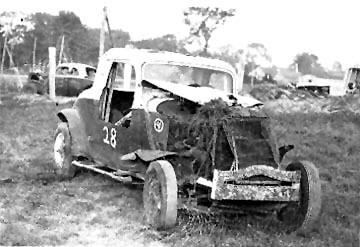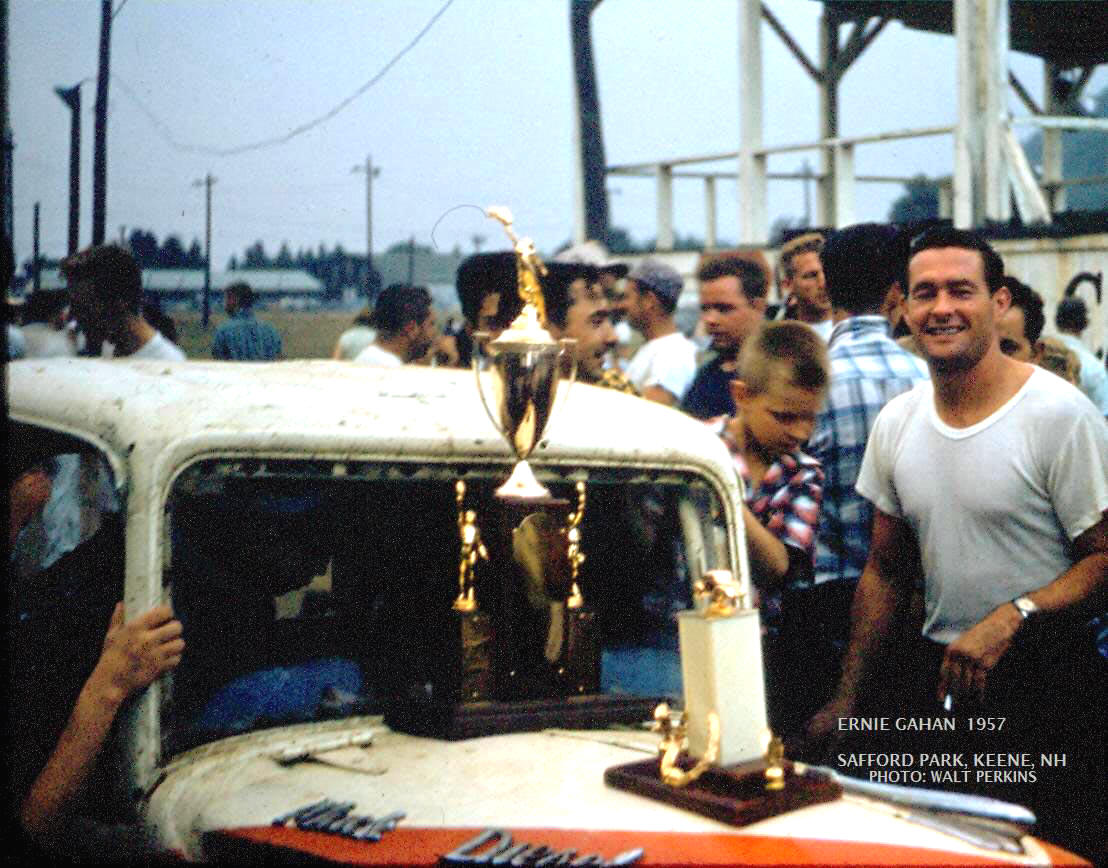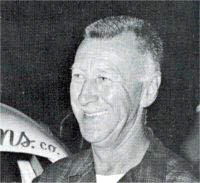|
|
Since I seem to have lost my forum, Mark
Thomas' "Racin' Paper", I will apparently enter the 21st Century and start doing
my column as a
blog. In certain times of the year, this may not be weekly; but I promise to
keep it regular. Many of the site regulars have only been able to
get my columns via this site, anyway, and representing the very newspaper that
was given out at Thunder Road gave me no press courtesies.
So, I might as well do it this way and reach some different readers. Let me know
what you think. -Bill
Week of July 30, 2012
|
|
SANFORD SPEEDWAY – SO TYPICAL OF THOSE
1950’s BOOM TRACKS THAT CAME AND WENT
Like so many other post – World War II booms, the explosion of stock car racing onto the American racing scene pretty much waited until the 1950’s, with only a few tracks running stock cars in the late 1940’s. The state of Maine was no exception. With a few venues like the Unity and Lewiston fairgrounds tracks getting a head start in the late ‘40’s, most of the tracks got their start around 1950 or 1951.
June 4, 1950 was the date when Sanford Speedway first opened for racing. As was the case with most such tracks, the original owners experienced problems making ends meet. Thomas Guillemette, a local saw mill owner, had purchased and cleared a sandy lot off Route 109 and had overseen the sculpting out of the scrub pine lot there of a track, with which he had hoped to cash in on the burgeoning sport of stock car racing. Although, before WWII, there had been some “mud buggy” racing in the region – these unsafe, roadster – like cars were not brought back after the war.
Sanford Speedway, as it turned out, was not the typical rustic bull ring, scratched out in a pasture with few amenities, as was the case with over half the race tracks of the day. David Dutch, in his articles about the track, describes just how hard Guillemette tried to make a top notch facility: “Guillemette was born in Canada and first worked in the local mills. He was a hard-working man who carved out his slightly less than a one-third mile track and built a 650 foot wooden grandstand that accommodated several thousand-race fans. He also put in the lighting for night racing and built a judges stand, a concession stand-ticket booth, restroom facilities, and a pit shack. The clay for the track's banks was hauled in from the banks of the Mousam River in West Kennebunk. The little "bull ring," as it was called by many, was the first paved track in Northern New England. The pit area was located between the second and third turns at the front of the slight backstretch with its entrance off turn 2, and exit just before turn 3. It was 60 feet wide and had four distinct turns, unlike most small tracks. Turns three and four were tighter than the first two.
PR Boston of North Berwick sprayed 4,000 gallons of tar on the oval, a sealer was later put on it giving it a fast racing surface. The old speedway was an engineering marvel and ahead of its time, but the semi-banked and paved oval proved to be a problem for most of the cars that were used to running on dirt. The centrifugal force and friction of the pavement caused the wheels and tires to come off. A stream of sparks showered the surface as the wheel or hub dug into the tar to the delight of the fans. The cars had also had difficulty holding the track and these problems eventually led to the track's demise. Later technology improved by modifying the chassis and springs, and they used a wider wheel and tires called racing slicks. The ingenious use of modified truck and other vehicle performance parts made for better racing. ”
From David Dutcher Article – Fosters Daily Democrat
Ray Normaneau, who just happened to be of French descent, won a
popular win in the inaugural Sanford program.
Like the owner, himself, a sizable percentage of the area supporters seemed to be of French Canadian descent, their families probably having come to work in the many mills in that area of Maine, just like other New England mill towns such as Winooski, Vermont and in northern Massachusetts. Crowds were treated to the best performance that the Sanford Stock Car Racing Association could provide. Again, unlike so many of the fly – by – night tracks in the Northeast, Guillemette’s track had a full slate of association officers [most with French surnames], and medical personnel.
According to Dutch’s research, the Sanford track had to contend with the odors emanating from across the road, at LeHoux’s Pig Farm. Uncomfortable spectators would be glad to have the nasty pig smell replaced, in the course of the show, by burning rubber, hot motor oil, and hopefully somebody’s hot dogs. Guillemette’s team tried their best to keep the crowds comfortable and entertained, supplying a liberal amount of country music throughout the program.
From the Maine Vintage Racing Site
Future Hall of Famer and Sanford Speedway participant Phil Libby had this run of
bad fortune at the Lewiston fairgrounds in 1949.
The opening show, delayed once by inclement weather, saw local fireman Ray Normandeau outlast future Maine racing hall – of – famer Dick Libby for the feature win, fighting through the dust and stones from the not – yet – paved oval. Racing at Sanford shaped up to be the locals, like Normandeau, against established Beech Ridge stars and some big – name drivers from New Hampshire. The locals never did quite handle the bigger stars. Local drivers included such as Normandeau; Sanford's Mac McDonald; Arnie Day, Alfred; Dick "Fat" Allen, Larry Curit, and Dick Gagnon, all from Sanford; Ray Shaw; and future stars, Phil and Dick Libby. Other notable locals included: Dick Eon, Butch Boucher and Paul Tardif from Biddeford, and George Welch from Ogunquit.
Donny Moore Photo via David Dutch, Fosters Daily Democrat
Roger Rivers [furthest right standing] and his checkered car.
One of the highest – profile drivers was Dover, New Hampshire’s Roger “Cowboy” Rivers, with his checkerboard – painted Hudson. Rivers, described by the great Ernie Gahan as “a bull in china shop”, relished his image as the track villain. He was a rough driver and did little things to provoke the crowd. The Granite State contingent was a tough bunch to beat. The much – traveled Ernie Gahan, another Dover driver, was driving a well – financed Stoney’s Diner team car and would end up as the 1965 NASCAR National Modified Champion in his storied career.
Source Unknown
This grainy photo from a Beech Ridge program in the 1950’s
shows Gahan in one of the Stoney’s Diner team cars. Below -
Ernie Gahan wins a feature at Keene, NH’s Safford Park
race track in 1957. Gahan had begun his career at Sanford
and other McConnell venues.
Courtesy of Walt Perkins
Along with Gahan and Rivers, was Tony Collicchio, who would drive in a number of circuits before finishing a successful career at Barre, Vermont’s Thunder Road in the 1960s’. With Gahan and Collicchio, often traveled Charlie Zip [short for a long Greek name] came such luminaries as the Prince brothers, driving specially – built cars by Nash Couture, Bob Moore, and Hammerin’ Hank Ellsmore.
Alas, Guillemette, for all his industry, did not promote his shows well and the SSCRA disbanded at the end of the year. The following year, after the local Lions Club had tried their hand at running the track, a Portsmouth, NH group headed by Dan McCarthy established the Sanford Speedway, Inc. group and ran the show in 1951. They tried more promotion, such as having a local, well – known wrestler driver drive a car. In June of 1951 Guillemette and local businessmen Ralph Lovell and Raoul Juneau mortgaged the property as the Sanford Speedway Inc. The operators introduced a jalopy division, but ended up back with the “modifieds” of Gahan and his counterparts at the end of the season.
With 1952 came a new season and the need for another promoter. Enter local racing promoter Jim “JB’ McConnell, who decided to branch out from his successful Beech Ridge Speedway operation and run the Sanford Speedway, near Sanford and Wells, Maine. McConnell had been experimenting with putting on shows at several Maine locations where he could just lease existing tracks [mostly fairground ovals]; but, Sanford was actually built for the purpose.
Source Unknown
J.B. McConnell
The McConnell operations were – for that era – fairly smoothly – run productions, complete with a specially – lettered truck, a permanent set of officials, and the organization’s own doctor, who brought along an ambulance [at a time when a lot of tracks used a local hearse or someone’s station wagon]. Foster’s Democrat writer David Dutch wrote about this “staff” : “McConnell brought his officials including Robert "Doc" Christopher, track doctor and his ambulance, and flagman Harold "Lefty" Ellis from Beech Ridge. Ellis was a flamboyant; devil may care character and the darling of women in the stands. According to the Maine Motorsports Hall of Fame:Lefty was one of the early "daredevil' flagmen, controlling the race on the track with stock cars roaring by within a few feet of his unprotected body. One his favorite "death defying" stunts was to stand in the middle of the track, waving the green flag as the stock cars raced by on both sides. ”
McConnell’s Maine State Stock Car Racing Association brought with it a lot more clout than one single track operator could wield – especially in the area of publicity. The MSSCRA instituted a new support division called the Bombers, which – as it did at Beech Ridge – offered the novice and less – experienced man a chance at the sport. It was in this class, similar to the B Coupes of later years, that stars like Dick Wolstenhume and Dick McCabe got their starts.
From the Maine Vintage Racing Site
The McConnell dog and pony show came in with this
elaborate [for that era] speedway truck.
This Bomber class – while furnishing good action and a chance to race – would be a good part of the cause of Sanford Speedway’s downfall. McConnell was all – too familiar with how tenuous was crowd safety in those days. At his flagship track , Beech Ridge, he had seen a fast car out of Utica, NY nearly go through the catch fence on the main straightaway, a year or so before. His promotional slogan of “Thrills, Spills and Plenty of accidents" became prophetic.
The crowds had long become used to helter – skelter action, with cars leaving and returning to the track, and much contact all around from many inexperienced Bomber drivers going too fast for their skills. On Sunday, August 26, 1953, when a wheel, hub and part of the axle flew off Bob Moore's car and penetrtated a 20-foot catch fence, killing 60-year-old spectator, Joseph William DeRoche of Sanford. This accident and a few others led to the closing of what had been one of the more successful of that time in that region.
USGS Terraserver Photo
The once – well –laid – out Sanford Speedway site was still visible on satellite photos in the 1990’s.
Today, Beech Ridge Speedway continues on, as strong as ever; but, it is difficult to even find traces of Guillemette’s once – well – built little third mile facility. Much like others of its era, like Champlain Speedway, in Ticonderoga, NY; Pico Raceway, in Rutland, VT; and the Rhythm Inn track in Millers Falls, MA – it disappeared into history. These tracks died from safety concerns, nonpayment of incurred debts, and from the obsolescence of the type of racing they featured. But, all those Sanfords all over the Northeast played a major role in bringing the sport of stock car racing along.
I wish to acknowledge that a lot of the historical material for this column came from David Dutch’s beautifully – written three – part series on the Sanford track, as seen in the Foster’s Daily Democrat website. It seemed pointless to repeat the same research, already so well done. I hope it gives David some additional audience for his work.
Courtesy of Frank Simek
Ernie Gahan, of Dover, NH is arguably the most famous graduate
of Sanford Speedway’s ranks.
Please email me at wladabou@comcast.net if you have any photos to lend me or information and corrections I could benefit from. Please do not submit anything you are not willing to allow me to use on my website - and thanks. For those who still don’t like computers - my regular address is: Bill Ladabouche, 23 York Street, Swanton, Vermont 05488.AS ALWAYS, DON’T FORGET TO CHECK OUT MY WEBSITE: www.catamountstadium.com
Return to the Main Page
Return to the Main News Page
Return to the All Links Page
Return to the Weekly Blog Links Page






